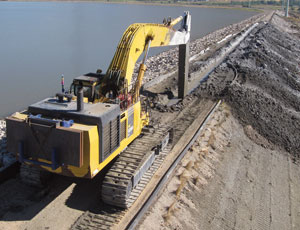A near failure of Arthur V. Watkins Dam, a leaking U-shaped earth-fill levee structure located 10 miles northwest of Ogden, Utah, is prompting a compressed-schedule repair, squeezing two years of work into one. The dam was within a few days of failure, U.S. Bureau of Reclamation officials say, threatening lives and major flood damage to surrounding property. General contractor Geo-Solutions Inc., New Kensington, Pa., is consequently running double shifts and using specially modified equipment to speed up repair work. It designed a 150-cu-yd-per-hour slurry plant fed by twin 60-ton silos for three times the output of a typical facility. Geo-Solutions additionally customized a Komatsu PC1250 hydraulic excavator with a hybrid boom stick that can extend 85 ft for tough excavations.

The leak was discovered in November 2006 by Bureau of Reclamation officials along the 14.5-mile-long, 36-ft-high dam. Water was seeping at a rate of 100-150 gallons per minute across a 200-ft-long southeastern section. It is unclear when the leak began, but the reservoir was about 80% full at 175,000 acre-ft when it was discovered. Founding Fault.
The dam’s soft silt, sand and clay foundation dates back to 1955 and was blamed for the seepage. Gradual erosion created a half-dozen shallow sinkholes and seven sand boils 2 ft to 3 ft in diameter in the dam’s toe and south-drain canal. Officials took emergency action to lower the freshwater reservoir, Willard Bay, by 10 ft by using pumps and outlet works to discharge 100,000 acre ft of water into the Great Salt Lake. A 40,000-cu-yd reinforcing berm of sand, gravel and riprap was applied while Reclamation engineers conducted a thorough geotechnical investigation.
Responding to a request for proposals for repair, Geo-Solutions won the $17.43-million negotiated contract. Work entails excavating and placing new dam-embankment fill material, installing new drains and constructing a new 30-in.-thick cutoff wall. Nordic Industries, Marysville, Calif., is the earthwork subcontractor. The 5-mile-long, 1.5-million-sq-ft cement-bentonite slurry wall slices through the dam’s crest and is embedded in clay under its sandy foundation. The 50-ft to 70-ft-deep structure will help intercept water seepage. “I believe it’s a record for a cement-bentonite slurry wall in terms of length and area,” says Chris Ryan, president of Geo-Solutions.
The project broke ground in July, and the contractors expect to finish 65% of the work this year. “The first milestone is the most critical, allowing the water district to partially refill the reservoir in the spring,” says Brandt Demars, field engineer for BuRec’s Provo, Utah, office. The repair project currently is ahead of schedule and is expected to be completed by next summer.

Post a comment to this article
Report Abusive Comment